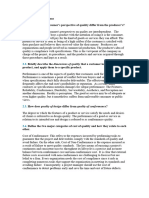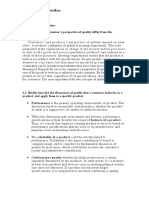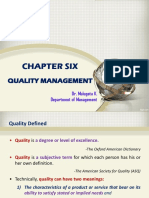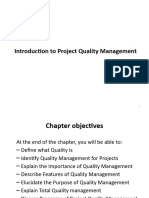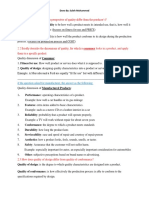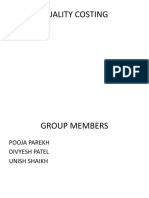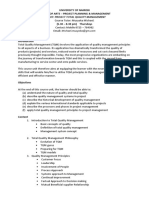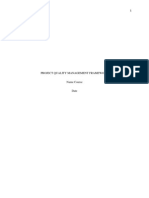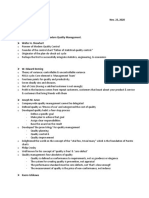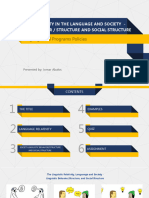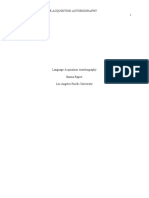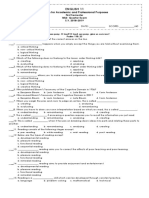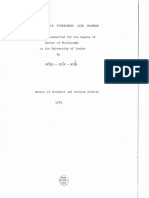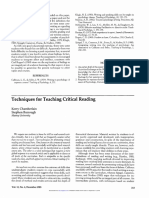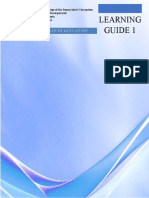Assignment#2 Questions
2.1. How does the consumer’s perspective of quality differ from the producer’s?
A producer's definition of quality is meeting requirements. This is the perspective
of the organization in charge of the project and processes, as well as the products and
services acquired, developed, and maintained as a result of those processes.
Meeting requirements means that the person who builds the product does so in
accordance with the specifications. Requirements can be very detailed or very simple,
but they must be defined in a measurable format so that they can be determined
whether or not they have been met.
The following four characteristics characterize the producer's perception of quality:
Doing what is right
Doing it correctly
Doing it properly the first time
completing it on time and within budget
2.2. Briefly describe the dimensions of quality that a customer looks for in a
product, and apply them to a specific product.
The product performance frequently influences the end-profitability user's or
reputation. As a result, many contracts or specifications include penalties for poor
performance.
While this dimension may appear to be self-evident, performance specifications
rarely define the features that must be included in a product. As a result, it is critical
that suppliers designing products or services based on performance specifications are
familiar with their intended applications and maintain close relationships with end-
users.
Most end-users consider reliability to be a fundamental dimension of quality, and
it is a major contributor to brand or company image.
Serviceability (along with reliability) is becoming an increasingly important
dimension of quality and criterion for product selection as end users become more
focused on Total Cost of Ownership rather than simple procurement costs.
The appearance of a product is important to end users. The aesthetic properties of
a product contribute to the identity of a company or brand. Faults or defects in a
product that reduce or change its aesthetic properties, even if they do not reduce or
change other dimensions of quality, are frequently grounds for rejection.
This study source was downloaded by 100000823562058 from CourseHero.com on 09-13-2022 09:17:48 GMT -05:00
https://www.coursehero.com/file/87420456/ASSIGNMENT2docx/
� Reality is defined by perception. The product or service may have adequate or
even superior quality dimensions, but it still suffers from negative customer feedback.
2.3. How does quality of design differ from quality of conformance?
There are two main approaches to dealing with design and conformance quality
conflicts. The first is a contingency approach, which aims to determine the correct
prioritization of the two dimensions and allocate resources accordingly.
It focuses on contextual variables such as industry, product, and organizational
life cycle stages; organizational technology; generic competitive strategy;
international strategy; and uncertainty level. The second option is to use an
integrative, or synergistic, approach, which is based on the win-win principle that
improving one element can help improve another.
2.4. Define the two major categories of cost of quality and how they relate to each
other.
Many people are confused by the term "cost of quality." It does not include the
cost of using the highest grade steel to make a watch or the best quality mahogany to
build furniture instead of fir or redwood.
Instead, the term "cost of quality" refers to all costs incurred to prevent product
defects or costs incurred as a result of product defects. Within the definition of Cost of
quality, there are two major categories. They are the Cost of Conformance and the
Cost of Nonconformity.
These expenses are incurred in order to keep defective products out of the hands
of customers. The cost of conformance is made up of two components: prevention
costs and appraisal costs.
These costs that are incurred since damage occurs despite the organization's ways
to protect them. As a result, these costs are also known as low-quality costs. When a
product fails to meet its design specifications, these failure costs are incurred. The
cost of noncompliance is made up of internal and external failure costs.
2.5. What is the difference between internal and external failure costs?
The costs associated with providing low-quality products or services are referred
to as the cost of poor quality. There are three types:
Appraisal costs are the expenses incurred to determine the degree of
conformance to quality standards.
Internal failure costs are the costs associated with defects discovered before
the product or service is delivered to the customer.
This study source was downloaded by 100000823562058 from CourseHero.com on 09-13-2022 09:17:48 GMT -05:00
https://www.coursehero.com/file/87420456/ASSIGNMENT2docx/
� External failure costs are the costs associated with defects discovered after the
product or service has been delivered to the customer.
Pereira, R. (2020, May 14). 8 Dimensions of Quality. Retrieved from
https://blog.gembaacademy.com/2008/05/28/8-dimensions-of-quality/
Quality of design and quality of conformance: Contingency and synergistic
approaches. (n.d.). Retrieved from
https://www.tandfonline.com/doi/abs/10.1080/14783360500450640?
journalCode=ctqm20#:~:text=
Simplilearn. (2021, March 05). Project Quality Management: Cost of Quality.
Retrieved from https://www.simplilearn.com/project-quality-management-cost-of-
quality-article#:~:text=
Cost of Quality (COQ). (n.d.). Retrieved from https://asq.org/quality-resources/cost-
of-quality#:~:text=
This study source was downloaded by 100000823562058 from CourseHero.com on 09-13-2022 09:17:48 GMT -05:00
https://www.coursehero.com/file/87420456/ASSIGNMENT2docx/
Powered by TCPDF (www.tcpdf.org)

